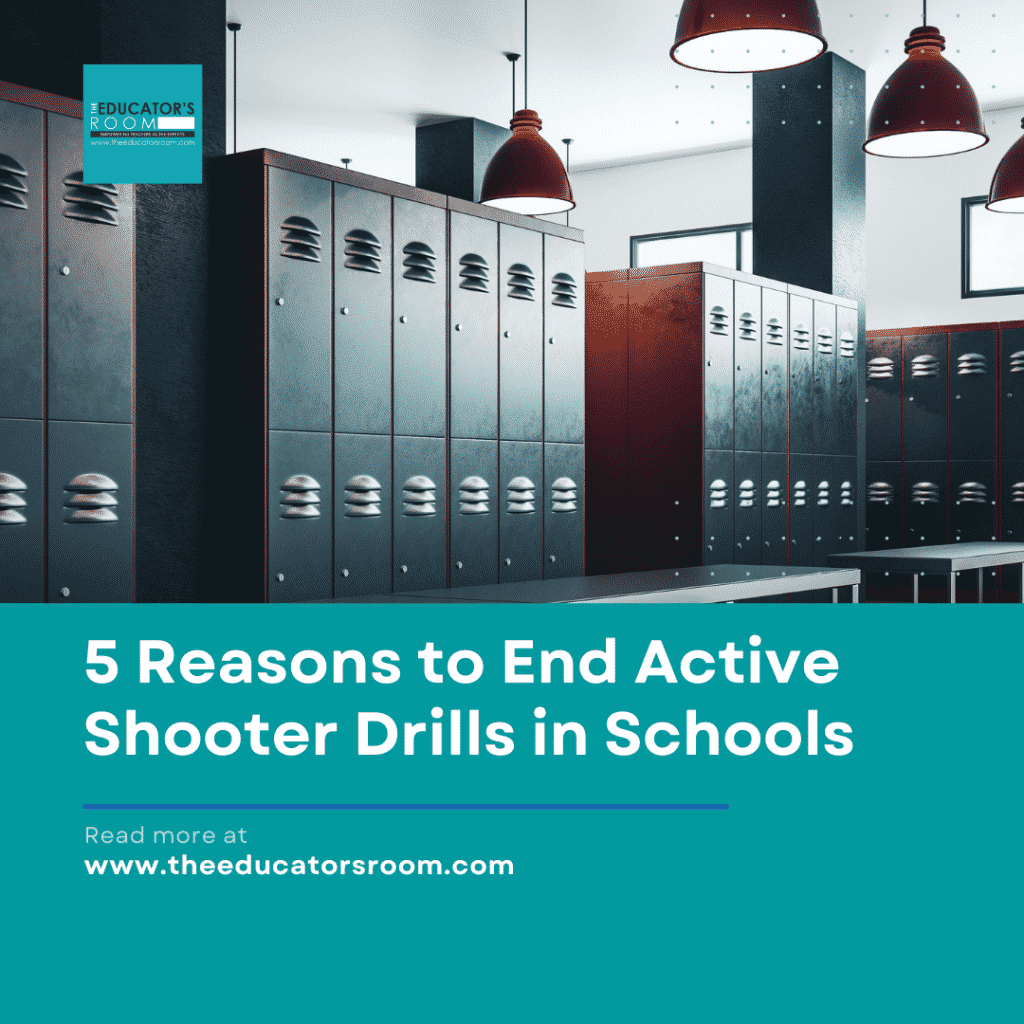Overview:
Forty states require public schools to conduct these drills but give little to no guidance on what that should look like or entail for our students.
As we head into warmer afternoons and the end-of-year traditions, it’s natural to reflect on the year that’s been. This year felt far from normal as we navigated the rollercoaster of schooling during the pandemic. But some things did return to normal, including mandated active shooter drills. Forty states require public schools to conduct these drills but give little to no guidance on what that should look like or entail for our students. It’s time to reconsider how we address school safety.
Several years ago, I arrived for a fall professional development day. I found fatigue-clad former Navy Seals crowded before a PowerPoint presentation entitled “Surviving an Active Shooter Event.”
This for-profit company walked us through terrifying scenarios for the next several hours. Mass shootings from the past ten years were dissected in detail, down to the number of rounds discharged. At one point, a gentleman with biceps as thick as tree trunks attempted to bring levity to a serious topic. “You know who you need to treat well, right? The gal at the front desk. I mean, she’s the gatekeeper. She’ll send them right to your room if you’re not careful.”
After that tasteless “joke,” I knew I was in for a traumatizing day. Sure enough, I would be “shot” several times after cowering in a corner, and our school principal would be “assassinated” at her desk. Afterward, we sat together as the consultant walked us through what we should not say to media outlets after a potential tragedy. I cried angry tears driving home.
Extreme unannounced simulation drills should be criminal, and schools should seriously reconsider all active shooter drills. Here are five reasons these drills are flawed:
1. Active Shooter Drills are Big Business
Responding to the potential threat of a school shooting has become a $2.7 billion industry. From bulletproof backpacks to a $4,000 armored classroom door, products have flooded the market, preying on our greatest fear, the loss of our children. This fear has convinced school administrations to purchase security technologies and training programs. Every administrator feels enormous pressure to answer the question, “What are you doing to protect my kid from a school shooting?” These companies provide answers. They provide a school with talking points and products to install. There is little to no evidence that any of these things work.
A quick search of the internet will deliver an endless number of companies willing to train your staff for the next lockdown/lockout drill. They’ll insist you have 6-10 of them a school year and utilize their services to dissect the drill’s effectiveness. Until recently, they’d even shoot your unsuspecting teachers with plastic pellets (for an extra fee).
Now that most schools are equipped with security technologies, consultants upsell the “new and improved” technologies. It’s not a one-and-done shopping experience. If you really care about your students, you’ve got to upgrade and upgrade often. Their motives might not be sinister, but they are certainly opportunistic. Schools need to view these companies with appropriate skepticism instead of blind allegiance.
2. Active Shooter Drills Ask Teachers and Students to be Rambo
During a debriefing session, consultants repeatedly asked teachers, “So what do you think you did wrong there?” Teachers nervously laugh as they realize they’ve failed to administer the correct technique for an unpredictable attack. The responsibility of preventing deaths and injury is placed squarely on the shoulders of teachers and children. A standard plan in these drills is “Run, Hide, Fight.” For some schools, that means asking students to practice grabbing scissors, large projectiles, and anything they can get their hands on to disrupt an armed intruder. It’s emphasized that this should be an absolute last resort, but it’s practiced nonetheless.
One elementary school has even stocked classrooms with buckets of river rocks to use against an attacker wielding an automatic weapon. The enormous pressure on teachers and students to “get it right” and defend their classroom is wrong. We’ve heard it said again and again, “We want children to feel safe in school.” How can students and teachers feel safe when the school’s message is: “At any moment, a gunman could enter this room, so we better be ready.”?
Children are saddled with the enormous burden of being prepared to enact a complex protocol during drills. The ALICE program uses Alert, Lockdown, Inform, Counter, and Evacuate as the elements of its acronym. It’s a complicated approach and requires young children to analyze complex situations, applying varying responses. It’s simply not developmentally appropriate.
3. Active Shooter Drills are Traumatizing
Teachers and students are not okay after active shooter drills. According to recent research, there is a 39% uptick in depression and a 42% increase in stress and anxiety among students in the months following an active shooter drill. Once time has passed and this uptick decreases, it’s time for the next drill.
According to Lily Eskelsen Garcia, president of the NEA, “Everywhere I travel, I hear from parents and educators about active shooter drills terrifying students, leaving them unable to concentrate in the classroom and unable to sleep at night. That is why, if schools are going to do drills, they need to take steps to ensure the drills do more good than harm.”
The Atlantic explored this problem in detail and made a significant case for ending drills. “Preparing our children for profoundly unlikely events would be one thing if that preparation had no downside. But in this case, our efforts may exact a high price.” The article revisits the “duck and cover” campaign of the 1950s in response to fears of nuclear holocaust. At that time, some children in New York were even issued dog tags to be worn every day so their parents could quickly identify their bodies later.
That seems absurd now, but we are navigating a similar road with our most extreme active shooter drills. For many teachers, we know in our gut these drills are causing more harm than good. In one school, a first-grader implored her teacher to reconsider having baby chicks in their classroom. She was worried that the birds would chirp and the bad guy would find them. The baby chicks should stay.
4. Active Shooter Incidents Are Still Extremely Unlikely
The reality is that 999,999 out of 1,000,000 students will complete their education without ever facing an armed shooter. However, more than 95% of all children will practice responding to this attack multiple times each school year. Many students will participate in over 70 active shooter drills before they graduate. Fortunately, for the vast majority, that will be the only gun-related trauma in their childhood. It’s an unnecessary trauma.
5. Active Shooter Drills Don’t Work
On November 30, 2021, the deadliest school shooting since May 2018 took place at Oxford High School in Michigan. The school regularly completed active shooter drills. So did the shooter. He was able to time his attack during a busy transition period in the halls. He knew it would be the ideal time based on the drills he’d practiced with his classmates.
Even though students quickly hid in classrooms and barricaded doors, four students were killed, and seven others were injured. These drills are not the solution to school shootings. The variables of how, when, and where make it impossible to respond to a shooter in a way that prevents death. Some would argue that the students’ training saved lives that day.
However, the 15-year-old armed student completed enough damage in the hallways. No active shooter has shot everyone on campus, so technically, you can always say these drills “save lives.” What would have saved everyone’s lives and prevented extreme trauma was a search of Crumbley’s backpack when he was in the office that morning.
He’d been removed from the classroom over red flags displayed days and hours before the shooting. The teachers did the right thing. They saw something and said something. Unfortunately, vital preventative steps never took place, leading to “Run,” “Hide,” and “Fight” being the only answer left.
Schools Need Meaningful Change
Schools should implement safety measures to keep their campuses secure and have a dynamic system to ensure red flags aren’t missed and are addressed appropriately. Awareness of the school environment and students’ mental health is a more effective way to create a safe school than these drills. It also has an added benefit. Children feel seen and know they matter to teachers and administrators. They’ll also know their teachers are doing more to protect them than stocking up on scissors.
We can build environments that interrupt the molding of potential school shooters by assessing potential threats and using our knowledge of adolescent development. We are better at detecting concerning behavior than we were 20 years ago. No one saw Columbine coming. Multiple adults at Oxford High School saw issues with Crumbley.
In recent years, multiple shooter plans have been thwarted with incredible success. Zero lives lost. They weren’t successful because of a lockdown. Nothing ever reached that point. Instead, concerned classmates and teachers pointed authorities in the right direction, and stockpiles of guns and ammunition never left these boys’ bedrooms. The media rarely gives these heroic interceptions any attention. They should. It would make it easier to understand that there indeed are solutions that are better than arming teachers and running active shooter drills once a month. In 2022 we can do better. We can think logically and develop school safety plans that work. We can save lives and protect the innocence of childhood.
Editor’s Note: If you enjoyed this article, please become a Patreon supporter by clicking here.








Reason 5 is an especially excellent point. Sad but true.